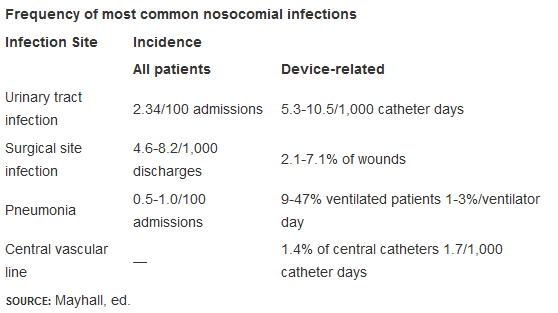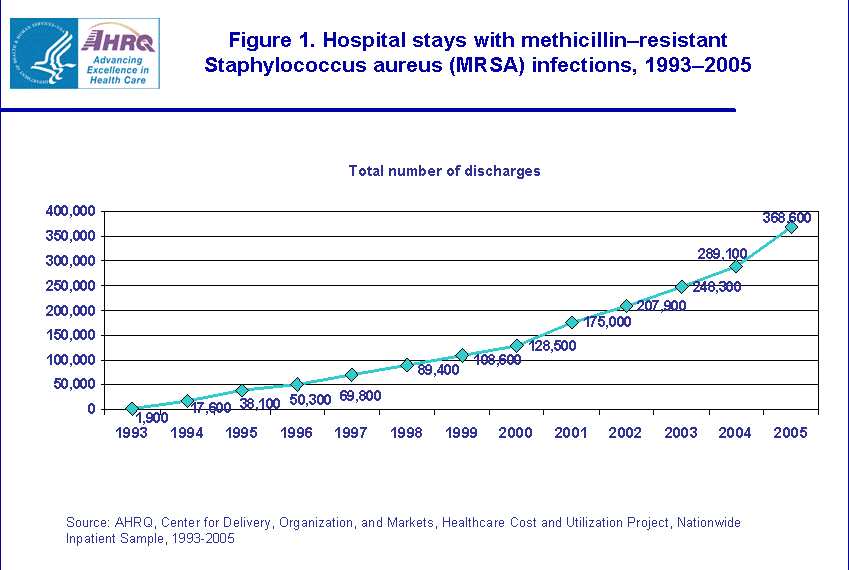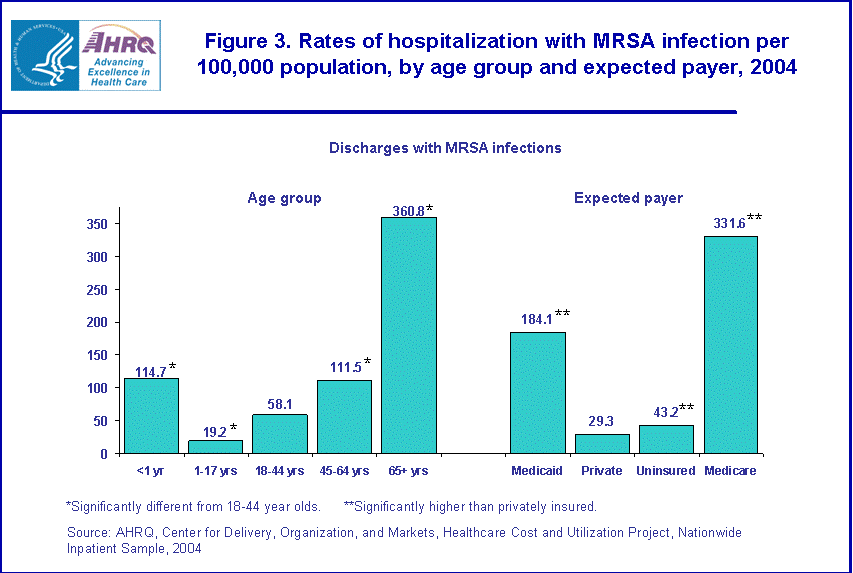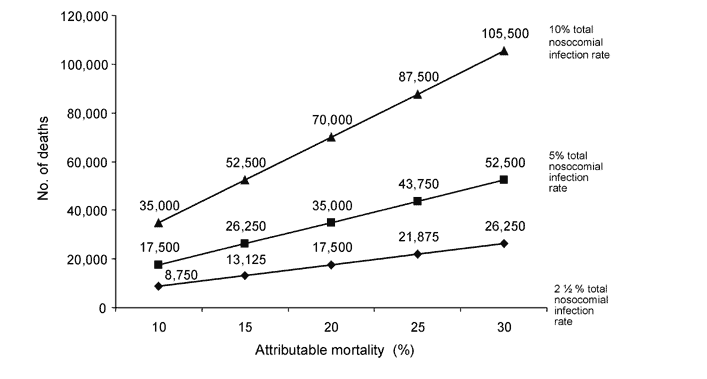Hospital-Acquired Infection, Research Paper Example
Abstract
This paper explores the concept of Hospital-acquired infections, appropriate to the study of microbiology. The paper is divided into the following parts: (1) Introduction and Background (2) Definition and Types (3) Infection Rates (4) Conclusion. We look at the origins of the acquisition of hospital acquired infections and how these are relative today. The types of infections are defined together with suggested reasons for the cause of these. An examination into how the hospitals are addressing these problems and the actions being taken. The importance of infection rates in the USA and how these are contrasted to other countries with specific reference to World Health Organisation statistics. Finally, how the situation is brought under control and the projected outlook for the future.
Introduction and background
Within hours of admission to a hospital the patient becomes exposed to the characteristics of the hospital bacteria pool. Most hospital-acquired infections tend to manifest themselves within 48 hours of admission. The hospitals have had surveillance, prevention and controls in place since the 1950’s. It was not until the 1970’s that matters started to really improve with the introduction of infection controls. This showed “nosocomial rates would be reduced by 32% if infection surveillance was used in conjunction with infection control”. (Ayesha Mirza, 2010). The type of infections may derive from either endogenous or exogenous sources. With the endogenous types these are normally derived from nasopharynx or genstousinary tracts. The exogenous types are mainly from acquisition from visitors, medical staff, other patients and the hospital environment. “Healthcare-associated infections are estimated to occur in 5% of all hospitalizations in the United States” (Ayesha Mirza, 2010). This contrasted to overseas countries” a World Health Organization (WHO) cooperative study (55 hospitals in 14 countries from four WHO regions), about 8.7% of hospitalized patients had nosocomial infections” (Ayesha Mirza, 2010).
Early causes to the infections have focused upon cleanliness in the hospitals and particular attention to the lack of sterilization of beds because of staff shortages “It is thought that one of the major causes of HAIs is “hot bedding” – when a patient’s bed and surrounding area is not vacant long enough for proper cleaning, due to hospital staff being under pressure to meet increasing targets” (Private Healthcare UK, 2010). In more recent years this has given rise to what has been termed as “superbugs”[1] that are considered to be a more virulent and resistant strain of infections and less responsive to anti-biotics. The illustration to the right provides a tabular description of the most common nosocomial infections (Nicolle, 2002).

Figure 1: Source Nicolle 2002
Definition and types
Most types of infections are based upon the introduction of micro-organisms that are either in the body or exposed to elements outside of the body” Hospital-acquired infections can be caused by bacteria, viruses, fungi, or parasites. These microorganisms may already be present in the patient’s body or may come from the environment, contaminated hospital equipment, health care workers, or other patients. Depending on the causal agents involved, an infection may start in any part of the body” ( , ).

Figure 2 : Source Anne Elixhauser 2007
The illustrations to the right show the increasing trend in the MRSA (superbug) infections from patients being discharged from 1993 to 2005. This relates to research conducted by Anne Elixhauser, Ph.D. and Claudia Steiner, M.D., M.P.H. in a number of US Hospitals. (Anne Elixhauser, 2007) Patients who undergo surgery are often at risk from MRSA infection, similarly those having suppressed immunity. Figure 1 illustrates that there is a relatively alarming trend in US hospitals that are being faced with the superbug problem the chart illustrates some 368,600 cases of MRSA infection, increasing by more than 30% after 2004

Figure 3 : Source Anne Elixhauser 2007
Figure 3 zooms in on the rates of hospitalization with MRSA infection per 100,000 population incidence. The highest rates for MRSA infection being for those over 65 years of age.
Another danger that the hospital faces is infection that is caused as a result of surgical procedures. This may result from the insertion of catheters (tubes) into urinary tracts, nose, mouth, blood vessels or inhaled into the nose or mouth and then onto the lungs. One of the most common sources of infection relates to that of the urinary tract and surgical wound infections. Children seem at increased risk because of their relatively young immune system. Other patients with suppressed immune systems are particularly vulnerable i.e. those being treated for leukemia. Pneumonia is considered to be the most common type of hospital acquired infection. This is because bacteria and other micro-organisms are so easily introduced to the throat. This often by objects that are being used to treat respiratory illness. The microorganisms are able to quickly colonize in the throat and as such it is easy for the patient to inhale these into the lungs. Once in the lungs it quickly progresses into Pneumonia.
The first signs of infection are normally fever and rapid breathing. Issues with the urinary tract are often pain when urinating and blood in the urine stream. The hospital acquired infection is then determined by the medical team looking at the following procedures:
- Evaluating and analyzing the symptoms and signs of infection
- Examination of the site i.e. wound, catheter insert etc. Looking at sign of swelling or inflammation
- A complete physical examination
- The taking of a blood sample and a lab urine sample for analysis
- Chest X Ray where pneumonia is suspected
- Review of the surgical procedures that may have resulted in the infection
The hospitals make every effort to control hospital-acquired infections and these include some of the following important steps:
- An infection control program including quality control of procedures known to lead to infection together with a monitoring program to track infection rates.
- Employment of an infection control agent : normally examines1:200 beds
- Close scrutiny of high risk surgical procedures that may be at increased risk with infections
- Enforcement of hospital hygiene standards that include hand-washing by health care workers and visitors to avoid passing infectious microorganisms to or between hospitalized patients.
- Enforcement of antiseptic and sterilization procedures in the performance of procedures, including use of sterile gowns, gloves, masks, and barriers.
- Sterilization of all reusable equipment such as ventilators, humidifiers, and any devices that come in contact with the respiratory tract.
- Ensure that wounds have frequent dressing changes using anti-bacterial ointments
- Remove nasogastric (nose to stomach) and endotracheal (mouth to stomach) tubes as soon as possible.
- Apply antibacterial-coated venous catheter that destroys bacteria before they can get into the blood stream.
- Avoid contact between respiratory secretions and health care providers by using barriers and masks as needed.
- Employ silver alloy-coated urinary catheters that destroy bacteria before they can migrate up into the bladder.
Infection rates
Deaths resulting from hospital acquired infections may best be viewed in the graphical representation below. Where a hospital has a 5% nosocomial infection rate (10% being bloodstream related), then the mortality rate is 15%b or 26,250 deaths (depicted US model). (Edmond, 2001)

Figure 4 Source: Edmund RP
Significant improvements have been made in recent years by the introduction of anti-biotic hand cleansing agents in the hospitals and use of antibiotic-bonded vascular catheters. An ongoing program of sterilization and hygiene practices works towards an overall quality improvement program in helping to eliminate hospital acquired infections.
The World Health Organization produced an excellent report entitled “Prevention of Hospital acquired infections”. (Organization, 2001)A comprehensive report primarily based upon findings in Europe, with particular focus upon nosocomial infection sites. The pie chart illustrated below provides a visual understanding of the infection distribution as associated with hospitals in France.
What is most significant is the largest proportion of infections is related to the urinary tract. This is the most common nosocomial infection; 80% of infections are associated with the use of an indwelling bladder catheter (1,2,3). Urinary infections are associated with less morbidity than other nosocomial infections
Within England (UK) the Health Protection Agency (HPA) has stated that around 7000 patients are known to suffer from MRSA bacteria and in addition more than 50,000 patients in hospital over the age of 65 are known to suffer from clostridium difficite. The HPA reported that in 2009 there were more than 5000 deaths resulting from Hospital acquired infections.

Figure 5: Source World Health Organization, 2001
The situation in the USA is not much better and in 2009 a Health and quality report was submitted to Congress for review. The report stated that Hospital acquired infections were on the increase, comparing current data to that obtained in 2007. The following highlights were made in the report:
- 8% increase in blood infection after surgery
- 6% increase in urinary tract infection following the use of a catheter
- 6% increase in blood infection after use of a catheter
- 12% reduction in rates of pneumonia after surgery ( the main positive trend).
The number of deaths in the UK shows an alarming increasing trend with the period under review (see table below). Particularly with MRSA the mortality figures have increased 15 fold during the period between 1993-2002. This partly being attributed to the bacteria of MRSA becoming resistant to methicillin drugs.
The Centre for Disease Control (CDC) issued an alarming battery of statistics in their March-April 2007 journal. The study concluded that the results were very sobering and re-enforced the needs for improved surveillance and prevention measures. The numbers exceeded the number of cases of any current notifiable disease.
The situation in the United Kingdom is somewhat similar to that of the rest of Europe. There is one main exception and that is the UK has a much higher incidence of the ‘superbugs’(MRSA) – “Although Britain has a similar rate of hospital acquired infections as its European neighbours, it has far more MRSA infection. In fact, Britain has one of the highest rates of MRSA in northern Europe. In the UK, MRSA makes up 44% of all HAIs, compared with just 1% in the Netherlands.” (Aviva, 2009). The reason for the UK adverse situation is due to the fact that the strains of MRSA seem to spread more quickly than on the European mainland. As such many people in the UK become carriers of the disease. Another issue is the number of high bed occupancies in the UK and the link with poor hygiene and sterilization practices. In addition, many hospital nurses are not made sufficiently aware of infection control policies.
The disease is also turning up outside hospitals and has been found in both military barracks and agricultural farms “Methicillin-resistant Staphylococcus aurous is a bacterium that can cause terrible skin infections, pneumonia, blood poisoning, even death. It is resistant to common antibiotics, like penicillin, making it difficult to treat” (Marler, 2009).
Those found to be gaining an infection after surgery are more likely to be contaminated by their own bacteria, “If a patient is found to have an infection following surgery this is usually caused by the patient’s own bacteria (that is, bacteria they are already carrying at the time of the operation) rather than those present in the hospital environment or on the hands of healthcare workers.” (Kings College Hospital, 2010)
Dr Arup Malani a Professor at the University of Chicago and Dr Ramanan Laxminarayan are leading a comprehensive research study into MRSA for a Washington DC research laboratory. The superbugs cannot be treated by conventional anti-biotics and this makes them very dangerous “Sepsis, a condition where the whole body goes into a state of inflammatory response, and pneumonia, an infection of the lungs and respiratory tract, are two conditions often caused by deadly microbes, including resistant bacteria such as MRSA (methicillin-resistant Staphylococcus aurous). Such infections usually lead to longer stays in hospital and can lead to serious complications and even death.” (Arup Malani, 2010).
Conclusions
The research adequately demonstrates that the problem of Hospital acquired infections has been steadily getting worse since the 1990’s. The only bright light being the reduction in pneumonia cases from surgical procedures. The issue is not just in the USA but has world demographics including Europe, Canada, Australia and India. Not a great deal of information is available on the situation in South East Asia however some reports indicate that countries like Malaysia, Vietnam and Thailand suffer similar statistics to that of the USA and UK. Incidents of pneumonia after surgical treatment still appear high in China but there are no formal statistics that seem available in order to support that hypothesis.
Urinary infections seem to be amongst the highest level of hospital acquired infections on a world-wide basis. The situation has started to improve with the introduction of anti-biotic hand cleansing agents in the hospitals and use of antibiotic-bonded vascular catheters. Hospitals are working hard to develop programs of cleanliness and sterilization procedures, however there is no room for complacency with the emergence of new super bugs that become resistant to the range of antibiotics that are available. The UK is a prime example of needing to address the issue in accordance with the high number of bed occupancies and the need to maintain these in a sterile environment. The increase in MRSA mortality rates must rate as a high concern for the UK medical profession and getting this situation under control.
80% of hospitals in the USA are now using single gowns and drapes, as opposed to that of reusable materials. This is a great step forward in the planning towards elimination of hospital acquired infections. “. A recent statement from the College of Surgeons in Australia highlighted the situation regarding MRSA in that country.
The transmission methods of infections are primarily airborne, droplet or contact. Hence any good plan of hygiene, sterilization and hospital management must take into consideration all of these methods of introduction. The New York State Hospitals had the Governor sign a Public Health Law 2819 requiring hospitals in the state to report upon hospital acquired infections “Healthcare-associated infections are a major public health problem. According to the Centers for Disease Control and Prevention (CDC), there were an estimated 1.7 million healthcare-associated infections and 99,000 deaths from those infections in 2002” (New York State, 2010)
Works Cited
Anne Elixhauser, P. a. (2007, 7). Infections with Methicillin-Resistant Staphylococcus Aureus (MRSA) in U.S. Hospitals, 1993–2005. Retrieved 10 16, 2010, from H.Cup: http://www.hcup-us.ahrq.gov/reports/statbriefs/sb35.jsp
Arup Malani, R. L. (2010). Hospital-Acquired Infections, MRSA, Killed 48,000 Americans In One Year. Retrieved 10 17, 2010, from Medical News Today: http://www.medicalnewstoday.com/articles/180065.php
Aviva. (2009). A guide to hospital acquired infections. Eastleigh, Hants: Aviva.
Ayesha Mirza, M. (2010, 7 20). Hospital-Acquired Infections. Retrieved 10 16, 2010, from e-medicine: http://emedicine.medscape.com/article/967022-overview
Edmond, R. P. (2001, 4). The Impact of Hospital-Acquired Bloodstream Infections. Retrieved 10 16, 2010, from CDC: http://www.cdc.gov/ncidod/eid/vol7no2/wenzel.htm
Griffiths, C. (June 2004). Trends in MRSA in England & Wales. Health Statistics Quarterly, 15-22.
Kimberly Clarke. (2005, 5). Reducing the risk of hospital acquired infection . Retrieved 10 15, 2010, from Kimberly Clarke: http://www.kca.com.au/healthcare/docs/operatives/operatives-0505.pdf
Kings College Hospital. (2010). Hospital acquired infections – MRSA. Retrieved 10 17, 2010, from Kings College Hospital, London: http://www.kch.nhs.uk/patients/general-information/hai/
Marler, B. (2009). Methicillin-resistant Staphylococcus aureus (MRSA) causing illness in and out of hospitals . Retrieved 10 17, 2010, from Marler Clarke: http://www.mrsablog.com/
McGiffert, L. (2007). Sobering new statistics affirm seriousness of hospital infections in U.S. Retrieved 10 16, 2010, from Consumers Union: http://www.stophospitalinfections.org
New York State. (2010). Hospital-Acquired Infection (HAI) Rates in New York State Hospitals. Retrieved 10 17, 2010, from New York State: http://www.health.state.ny.us/statistics/facilities/hospital/hospital_acquired_infections/
Nicolle, L. E. (2002). Nosocomial Infections. Retrieved 10 16, 2010, from Healthline: http://www.healthline.com/galecontent/nosocomial-infections
Organization, W. H. (2001). Preventiopn of Hospital Acquired Infection. Geneva: World Health Organization.
Private Healthcare UK. (2010). What do we mean by hospital acquired infection? Retrieved 10 16, 2010, from Private Healthcare UK: http://www.privatehealth.co.uk/private-hospitals/hospital-infections-guide/hospital-infections/
[1] The two major ‘Superbugs’ are MRSA (methicillin resistant Staphylococcus aureus) and Clostridium difficile (C. difficile).

Time is precious
don’t waste it!

Plagiarism-free
guarantee

Privacy
guarantee

Secure
checkout

Money back
guarantee






